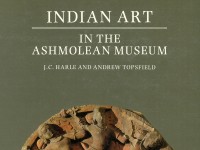Indian Art in the Ashmolean Museum
A catalogue of the Ashmolean’s collection of Indian art by J. C. Harle and Andrew Topsfield (published Oxford, 1987).

Publications online: 143 objects
Head of a Tirthankara, or Jain saviour
-
Literature notes
This detached head, with its exquisitely sensitive modelling, shows to what extent, even in the later Hindu period, tactile values of the highest order can be accommodated within a highly stylised conception. The median parting of the snail curls provides a strong vertical axis, from which the curls, in unusual wave-like patterns, appear to rush away. Perfectly ordered, their rows upon rows suggest nonetheless a rough turbulence which offsets any hint of effeteness in the smooth surfaces of the face below, over which the thin line of the eyebrows appears to wander with a life of its own. The emotional impact of this head, which is powerful, then emanates from the barely adumbrated depressions, even dimples, around the mouth and the lower part of the nose.
The head was almost certainly part of a stele and most likely had a halo. The pupils of the eyes are indicated by incised lines. -
Details
- Associated place
-
Asia › India › central India › Madhya Pradesh (probable place of creation)Asia › India › central India › Madhya Pradesh › north Madhya Pradesh › Gwalior division › Gwalior district › Gwalior (possible place of creation)
- Date
- 11th - 12th century (1001 - 1200)
- Material and technique
- grey sandstone
- Dimensions
-
with mount 37 x 16 x 15 cm max. (height x width x depth)
27 x 16 x 15 cm max. (height x width x depth)
- Material index
- Technique index
- Object type index
- No. of items
- 1
- Accession no.
- EAX.245
-
Further reading
Harle, J. C., and Andrew Topsfield, Indian Art in the Ashmolean Museum (Oxford: Ashmolean Museum, 1987), no. 53 on p. 45, p. 49, illus. p. 45
Location
Objects are sometimes moved to a different location. Our object location data is usually updated on a monthly basis. Contact the Jameel Study Centre if you are planning to visit the museum to see a particular object on display, or would like to arrange an appointment to see an object in our reserve collections.
Publications online
-

Indian Art in the Ashmolean Museum
This detached head, with its exquisitely sensitive modelling, shows to what extent, even in the later Hindu period, tactile values of the highest order can be accommodated within a highly stylised conception. The median parting of the snail curls provides a strong vertical axis, from which the curls, in unusual wave-like patterns, appear to rush away. Perfectly ordered, their rows upon rows suggest nonetheless a rough turbulence which offsets any hint of effeteness in the smooth surfaces of the face below, over which the thin line of the eyebrows appears to wander with a life of its own. The emotional impact of this head, which is powerful, then emanates from the barely adumbrated depressions, even dimples, around the mouth and the lower part of the nose.
The head was almost certainly part of a stele and most likely had a halo. The pupils of the eyes are indicated by incised lines.
Galleries
Notice
Object information may not accurately reflect the actual contents of the original publication, since our online objects contain current information held in our collections database. Click on 'buy this publication' to purchase printed versions of our online publications, where available, or contact the Jameel Study Centre to arrange access to books on our collections that are now out of print.
© 2013 University of Oxford - Ashmolean Museum








